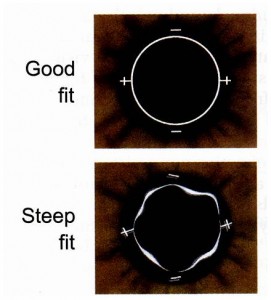In the precision prescribing of soft custom toric contact lenses, correcting for patients’ astigmatism and any potential cross cylinder effect, a repeatable over-refraction is of utmost importance.
In order to successfully accomplish this, a stable contact lens to cornea fitting relationship needs to be accomplished first. Once a successful fit of the soft custom toric contact lens is established, then an over-refraction may be completed. If residual astigmatism or a cross cylindrical effect is suspected, it is advisable to perform a spherocylindrical over-refraction over the custom soft toric contact lenses.
Once the spherocylindrical over-refraction is arrived at this can be placed into a cross cylinder calculator (Similar to SpecialEyes’ Over-Refraction Calculator found on their website - click here). The over-refraction information in conjunction with the amount and direction of the orientation markings is placed into the calculator and the next diagnostic lens is calculated.
If the patient’s custom toric contact lenses appear to be well centered with good movement on blink, however vision seems to fluctuate and the over-refraction is unable to alleviate the patient’s visual concerns, the prescriber must suspect the base curve may be inappropriate or the lens is not wetting or maintaining hydration properly. Performing manual keratometry over the top of the contact lens can evidence these occurrences.
Seat the patient behind the manual keratometer and attempt to focus the mires. After focusing is attempted, have the patient blink. If the mires are distorted initially and clear immediately after the blink, but distort again prior to the next blink, suspect the base curve is too steep. Reference the image below for a visualization of the mires over a properly fitted custom toric contact lens and a steep fitted custom toric contact lens.

If however immediately after the patient blinks the mires appear distorted and remain distorted suspect poor wettability of the custom toric contact lens. This wettability issue may be improved with removal and digital cleaning of the lens with a multipurpose disinfection solution system. The above issues can also be evidenced by viewing the videokeratoscopic rings while using a corneal topography system over top of the contact lens.
In the evaluation of patients’ visual acuity with soft custom toric contact lenses, a solid repeatable over-refraction will help to arrive at a successful final visual result more quickly for the patient and practice.
Matthew Lampa, OD, FAAO
Dr. Lampa is an Associate Professor of Optometry at Pacific University and a consulting optometrist to SpecialEyes.